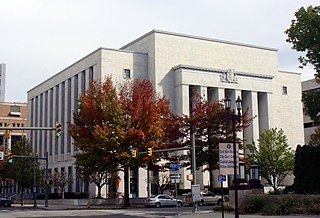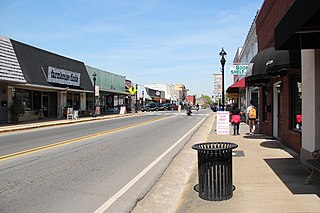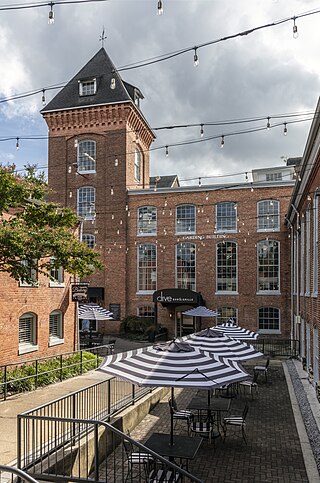Related Research Articles
This timeline of clothing and textiles technology covers events relating to fiber and flexible woven material worn on the body. This includes the making, modification, usage, and knowledge of tools, machines, techniques, crafts, and manufacturing systems (technology).

Schuylkill County is a county in the Commonwealth of Pennsylvania. As of the 2020 census, the population was 143,049. The county seat is Pottsville. The county is part of the Northeast Pennsylvania region of the state.

Dauphin County is a county in the Commonwealth of Pennsylvania. As of the 2020 census, the population was 286,401. The county seat is Harrisburg, Pennsylvania's state capital and ninth-most populous city. The county was created on March 4, 1785, from part of Lancaster County and was named after Louis Joseph, Dauphin of France, the first son of King Louis XVI. The county is part of the South Central Pennsylvania region of the state.

Fort Payne is a city in and county seat of DeKalb County, in northeastern Alabama, United States. At the 2020 census, the population was 14,877.

Cumru Township is a township in Berks County, Pennsylvania, United States. The population was 15,638 at the 2020 census. Nolde Forest Environmental Education Center, a Pennsylvania state park, is in Cumru Township.

Mohnton is a borough in Berks County, Pennsylvania, United States. It had a population of 2,927 in the 2020 census.

Wyomissing is a borough in Berks County, Pennsylvania, United States, adjacent to Reading. The borough was incorporated on July 2, 1906. As of the 2020 census, the population was 11,114, compared to 10,461 at the 2010 census. The growth was significantly larger between 2000 and 2010 largely because of its merger in January 2002 with neighboring Wyomissing Hills. Wyomissing is the most populous borough in Berks County.
Courtaulds was a United Kingdom-based manufacturer of fabric, clothing, artificial fibres, and chemicals. It was established in 1794 and became the world's leading man-made fibre production company before being broken up in 1990 into Courtaulds plc and Courtaulds Textiles Ltd.

The Savage Mill is a historic cotton mill complex in Savage, Maryland, which has been turned into a complex of shops and restaurants. It was placed on the National Register of Historic Places in 1974. It is located in the Savage Mill Historic District. Buildings in the complex date from 1822 to 1916.

Burlington Industries, formerly Burlington Mills, is a diversified American fabric maker based in Greensboro, North Carolina. Founded by J. Spencer Love in Burlington, North Carolina in 1923, the company has operations in the United States, Mexico, and India and a global manufacturing and product development network based in Hong Kong with over 8,000 employees on several sites in the United States, Canada and worldwide.

Fritztown is an unincorporated community in South Heidelberg and Spring Township, Berks County, Pennsylvania, United States. It is located along Fritztown Road to the west of U.S. Route 222 and approximately two miles northeast of the Berks and Lancaster County line and 3.4 miles southwest of Sinking Spring. The Cacoosing Creek begins here and drains northeastward into the Tulpehocken Creek, a tributary of the Schuylkill River. The area is experiencing population growth, due to new sub-divisions being built around the community. It is served by the Sinking Spring branch of the Reading post office, with the zip code of 19608.
Holeproof Hosiery was a Milwaukee, Wisconsin textile firm that was founded in 1901. The business was built primarily through earnings which were left to aggregate in the company. Its advertising expenses exceeded $500,000 after 1901, making it a brand name recognized worldwide. The business produced men's and women's hosiery, underwear, lingerie, and men's pajamas. From 1916 - 1925 Holeproof Hosiery sales increased from $2,037,000 to $9,220,000. Net sales totaled $24,435,342 in 1954.

Wyomissing Foundation is a private 501(c)(3) foundation in Wyomissing, Pennsylvania, United States. It was established in 1928 by three local businesspeople who had founded hosiery manufacturing company Berkshire Knitting Mills, later known as Wyomissing Industries. Grants from the foundation helped establish the Berks County Community Foundation, which was founded in 1994. In 2001, the Wyomissing Foundation donated a copy of Saving Pennsylvania, a video about the dangers of urban sprawl, to every public library in Pennsylvania. In 2008, the Foundation also helped support development of the Berks County Citizens Academy, a project to educate potential volunteer members of county and municipal advisory boards and authorities about local and county government issues.
Wigwam Mills is a hosiery company based in Sheboygan, Wisconsin, United States.
Kayser-Roth Corporation is an underwear and hosiery manufacturer based in Greensboro, North Carolina. The company currently markets three owned brands in North America: No Nonsense, Hue, and Burlington.
The Williams Valley Railroad was an anthracite-hauling railroad that operated in Schuylkill and Dauphin Counties, Pennsylvania from 1892 to 1971. For most of that time, it was a subsidiary of the Reading Railroad. It extended the Reading's Brookside Branch at Brookside 11 miles (18 km) down the Williams Valley to Lykens.
The Edgemont neighborhood is a community of mill works located in Durham, North Carolina. Previously known as Smoky Hollow, this area developed around the Durham Hosiery Mills in the late 19th century. Durham was a “raw whistle-stop village” along the Great North Carolina Central Rail Road that transformed into one of the largest tobacco cities in the United States. The Durham City Bull became one of the better-known tobacco trademarks with the help of the big players in the industry, W. T. Blackwell and Company and Julian Carr. The success of these tobacco mills started overflowing into other industries, mainly textile mills that produced cloth bags, socks, and other hosieries. As demands rose, communities began growing and changing around the factories. A shift in the racial make up of the workforce was reflected in Edgemont's shift to a more African American dominant community as the years progressed. Julian Carr Jr. was one of the first to allow black workers in factory level jobs to help cope with the high demands. This industrialist's decision to reach over the race barrier is part of what made Durham “the City of the New South.” The Edgemont Neighborhood is just one of many examples of how Durham became one of the more progressive and tolerant locations for African Americans in the country.
The Wilmington and Northern Railroad is a railway company that once owned a line from Reading, Pennsylvania to Wilmington, Delaware. The original main line from Wilmington to Birdsboro, Pennsylvania was built between 1869 and 1871 by its predecessor, the Wilmington and Reading Railroad. An extension from Birdsboro to High's Junction was completed in 1874. There the Wilmington and Reading connected with the Berks County Railroad and ran over its tracks to Reading. The Berks County Railroad was foreclosed on at the end of 1874 and reorganized as the Reading and Lehigh Railroad, under the control of the Philadelphia and Reading Rail Road. The Wilmington and Reading also experienced financial difficulties and was itself foreclosed on in 1876. It was reorganized in 1877 as the Wilmington and Northern. After the reorganization, the railroad was closely affiliated with the Reading, but retained its own organization and officers until 1898. In that year, the Reading bought a majority of the company's stock and incorporated it into its own system. The main line from Birdsboro to Wilmington became the Wilmington and Northern Branch, while the extension above Birdsboro was incorporated into the Reading Belt Line. The Wilmington and Northern continued to exist as a paper railroad within the Reading system. The portion of the Wilmington and Northern north of Modena, Pennsylvania was sold to Conrail at its formation in 1976. The line south of Modena was retained by the Wilmington and Northern, which leased and then sold it piecemeal to other railroads between 1981 and 2005. As of 2021, the Wilmington and Northern still survived as a subsidiary of Reading International, Inc.
Kraemer Textiles Inc. is a privately held American yarn manufacturing company founded in 1887, based in Nazareth, Pennsylvania. It produces its own handicraft yarns under the Kraemer Yarns brand, and spins natural and manmade fibers for carpets, industrial use, and home furnishings. It was one of the companies partnered with the Ralph Lauren Corporation to produce the distinctive outerwear for the 2014 Winter Olympics team representing the United States.

The Colebrookdale branch, also known as the Colebrookdale spur, Colebrookdale industrial track or Colebrookdale line, is a railway line in Pennsylvania. It runs 8.6 miles (13.8 km) from a junction with the Harrisburg Line in Pottstown to Boyertown. At its fullest extent, the line continued another 4 miles (6.4 km) to Barto. The line was built between 1868 and 1869 by the Colebrookdale Railroad and part of the Reading Company system until 1976. Berks County has owned the line since 2009. The Eastern Berks Gateway Railroad operates freight service; heritage passenger services are run under the Colebrookdale Railroad name.
References
- ↑ The United States Patents Quarterly. Associated Industry Publications. 1956. pp. 328–9.
- ↑ "Nepenthes On Running Cloudmonster Editorial | SneakerNews.com". Sneaker News. April 15, 2022. Retrieved December 11, 2022.
- 1 2 3 4 5 6 "About | The Railroad Sock". Therailroadsock. Retrieved December 12, 2022.
- 1 2 3 4 5 6 7 8 Montgomery, Morton Luther (1909). Historical and Biographical Annals of Berks County, Pennsylvania: Embracing a Concise History of the County and a Genealogical and Biographical Record of Representative Families. J. H. Beers. pp. 1045 (George), 1046 (William).
- ↑ Textile World. Bragdon, Lord & Nagle Company. 1907.
- ↑ Industrial Directory of the Commonwealth of Pennsylvania. Pennsylvania, Department of Internal Affairs. 1925. p. 105.
- 1 2 Davison's Textile Blue Book: United States and Canada. Davison Publishing Company. 1910. p. 483.
- 1 2 Office, United States Patent (November 1954). Official Gazette of the United States Patent Office. U.S. Patent Office. p. 654.
- ↑ USPTO. "THE RAILROAD SOCK – Dwight S. Williams Company, Inc. Trademark Registration". USPTO.report. Retrieved December 11, 2022.
- 1 2 "Berks Places: Fritztown a long, winding village spanning 2 townships". Reading Eagle. May 2, 2022. Retrieved December 11, 2022.
- ↑ "Dwight S. Williams Co. v. Lykens Hosiery Mills, No. 7135". vLex. Retrieved December 11, 2022.
- ↑ Office, United States Patent (1913). Official Gazette of the United States Patent Office. The Office. p. 802.
- ↑ Polk's (Trow's) New York Copartnership and Corporation Directory, Boroughs of Manhattan and Bronx. 1909. p. 691.
- 1 2 3 4 5 6 "Dwight S. Williams Co. v. Lykens Hosiery Mills, 233 F.2d 398 | Casetext Search + Citator". casetext.com. Retrieved December 14, 2022.
- ↑ "Lykens Hosiery Mills – Matchbook Cover". Lykens Valley: History & Genealogy. March 20, 2020. Retrieved December 14, 2022.
- ↑ Federal Supplement: Cases Argued and Determined in the District Courts of the United States and the Court of Claims, with Key Number Annotations. West Publishing Company. 1956. pp. 214–217.
- ↑ States, United (1997). United States Code Annotated: Comprising All Laws of a General and Permanent Nature Under Arrangement of Official Code of the Laws of the United States, with Annotations from Federal and State Courts. West Publishing Company.
- ↑ Index of Trade-marks Issued from the United States Patent Office. The Office. 1965. p. 124.